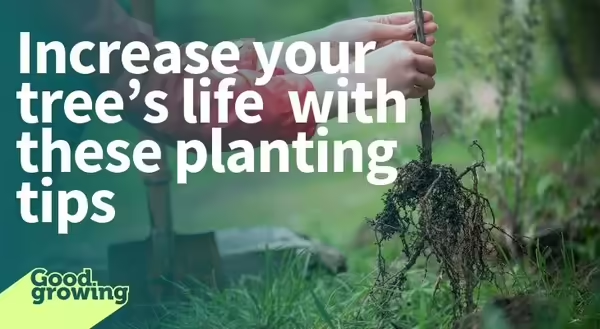
A tree is a long-term investment for a home. Truthfully, we often don’t plant trees for us, but for those that come after us. But many trees planted in a developed area don’t live past their eighth year. Here are some tips to help get your new tree past the eight-year hump and keep it going for generations.
Your tree is already planted too deep
Odds are good before you even buy your tree, it is planted too deep. Commonly, potted trees or balled and burlapped trees have had soil mounded against the trunk in the nursery, either from the nursery staff planting the tree too deep or from the soil being thrown against the trunk when they are cultivating weeds in the row. When planting the tree in its forever home, we want to make sure the root flare is above the soil line. The root flare resides at the base of the trunk where it flares out into the root system. Look around the forest and you will quickly see old trees flare out at the base. While tree roots are adapted to being in the soil, the root flare is not. If it looks like a telephone pole sticking out of the ground, it’s planted too deep. Remove potting soil from the top to expose the root flare and only dig the planting hole deep enough to accommodate the rootball while leaving the root flare above ground.
Your tree is choking itself
These days most trees are grown and sold in plastic pots. The problem with these pots is they promote circling roots. It may not seem bad in the container but given enough time the trunk and roots will expand to the point they will come into contact and the roots will strangle or ‘girdle’ the tree.
What can you do when you pull the tree out of the container only to find pot-bound circling roots? The answer requires some root pruning and elbow grease. Shake off as much potting mix using your fingers to pull out the circling roots. You can use a hose and water to wash off the roots of the tree to expose the interior of the rootball. Prune off any circling roots you can identify. The roots should radiate outward like the spokes of a wagon wheel. This may seem drastic, and it certainly can be stressful for the tree, but you’re setting up the root system for success.
Your tree is thirsty
Most people know you need to provide water to your tree as the roots become established. But how long should you provide supplemental water? A week? A month? More like two years. Certainly, the first month or two you should be watering routinely. It is important to know that it can take over two years for a tree’s root system to become established. So during a period of dry weather, your tree that was planted last year should be getting watered.
Wouldn’t it be something to have a lifetime where we could spend hundreds of years watching the life span of an oak? Unfortunately, we don’t have that opportunity, so we must live through the combined experience of generations. What better reason to put in a little extra work upfront, so the trees we plant can live out their lifetimes. Providing a shaded respite to those who come after us.
Good Growing Tip of the week: Most trees do not need to be staked. But sometimes a top-heavy tree needs some support. Make sure the staking material is loosely tied around the trunk to allow for movement in the wind and the ties are removed after one growing season.
Sign up for our emails! Want to get notified when new Good Growing posts are available? SIGN ME UP
MEET THE AUTHOR
Chris Enroth is a horticulture educator with University of Illinois Extension, serving Henderson, McDonough, Knox, and Warren counties since 2012. Chris provides horticulture programming with an emphasis on the home gardener, landscape maintenance personnel, and commercial landscapers. Additional responsibilities include coordinating local county Master Gardener and Master Naturalist volunteers - providing their training, continuing education, advanced training, seasonal events, and organizing community outreach programs for horticulture and conservation assistance/education. In his spare time, Chris enjoys the outdoors, lounging in the garden among the flowers (weeds to most).